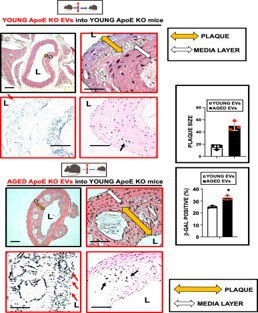Hernández I, Botana L, Diez J, Tesoro L, Jimenez B, Gonzalez C, Alcharani N, Zamorano JL, Saura M, Zaragoza C. CAP1: a novel extracellular vesicle marker linked to endothelial senescence in atherosclerosis
Biol Direct. 2025
"Cardiovascular age vs. Chronological age"- Dr Ignacio Hernández
Summary:
Endothelial senescence (ES) contributes to aging-related disorders and triggers a senescence-associated secretory-pattern (SASP), releasing Extracellular Vesicles (EVs), potentially impacting atherosclerosis. We used EVs from young (8 weeks) and aged (24 months) ApoE-knockout mice to detect ES in human aortic (HAEC) and coronary (CAEC) endothelial cells. Age-related atherosclerosis was confirmed by increased atheroma plaque formation in aged compared to young ApoE-knockout mice fed a high-fat diet, and the contribution of EVs from aged ApoE-knockout mice on ES was evidenced by a replicative senescence assay in cultured HAEC and CAEC, starting with the promotion of ES. A proteomic analysis depicted the recently PCSK9-associated CAP1 protein as a cargo component in EVs from aged animals and highly expressed in mouse and human endarterectomy plaques. Gene silencing of CAP1 inhibited HAEC and CAEC ES while overexpressing CAP1 in these cells restored the senescent-phenotype. The in vivo contribution of CAP1 was assessed by injecting CAP1-containing EVs isolated from aged ApoE-knockout mice into wild-type (WT) mice fed either a regular or high-fat diet. Compared to the EVs from young mice, the CAP1-containing EVs led to a pronounced ES along with the formation of intraluminal atheroma plaques. Similarly, young ApoE-knockout mice developed thickened and calcified atheroma plaques, along with increased ß-Gal-positive aortic staining when injected with EVs isolated from aged ApoE-knockout mice, like the atheroma plaques observed in aged ApoE-knockout animals. In conclusion, early molecular targets of ES may contribute to better management of atherosclerosis, in which here we unveiled CAP1 as a new molecular target.
Why do you highlight this publication?
We have identified for the first time a new biomarker that is easily measurable in blood samples, allowing us to better stratify and assess individuals at risk of developing cardiovascular disease and track its progression, even at a subclinical level.
Publication commented by:
Dr Ignacio Hernández Navarro
CARDIOVASCULAR DISEASES group
IRYCIS



